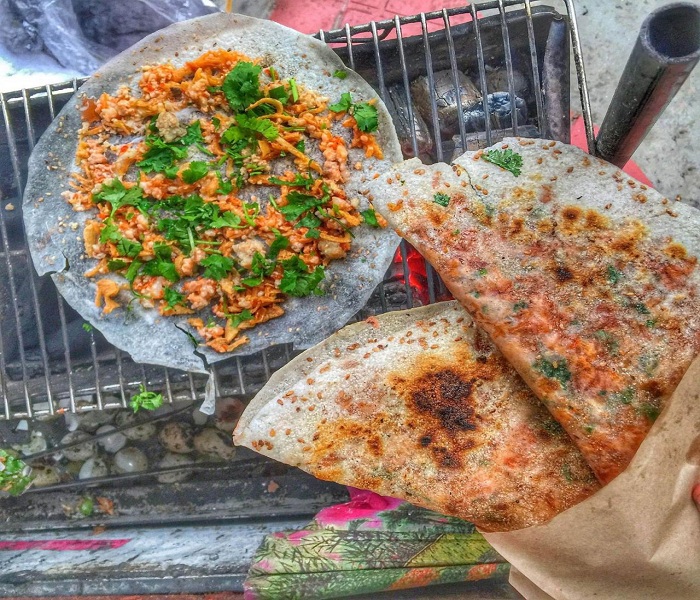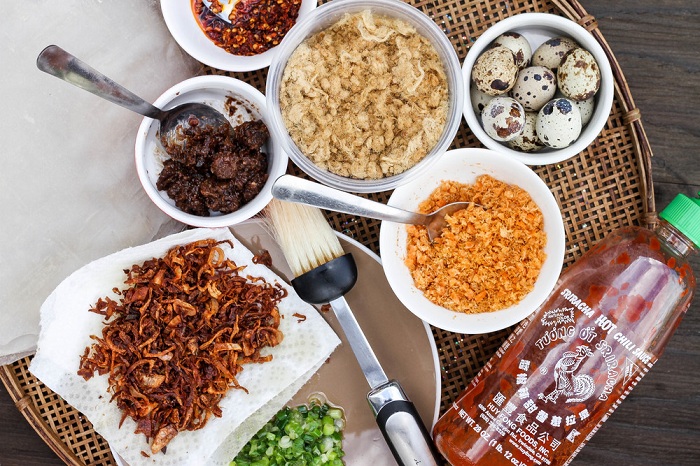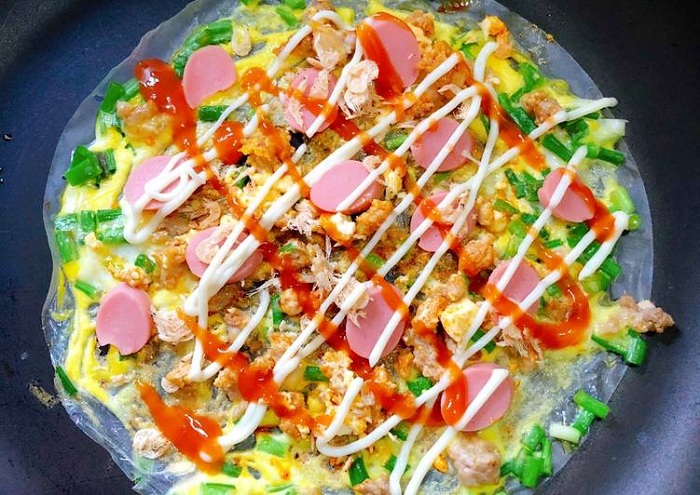
Bánh tráng nướng là món ăn đặc trưng của Đà Lạt mà bất cứ ai lúc đến đây cũng yêu cầu thưởng thức. Không chỉ là nổi giờ đồng hồ trong nước nhưng mà món bánh tráng nướng bình dân này là 1 trong món ăn uống đường phố rất lừng danh với du khách nước ngoài. Vậy bánh tráng nướng tiếng Anh là gì? và trong mắt khách khu lịch nó như vậy nào? Hãy cùng siêu thị nhà hàng Việt mày mò qua bài viết dưới đây.
Bạn đang xem: Bánh tráng nướng tiếng anh
Bánh tráng nướng trong tiếng Anh là gì?
Việt phái mạnh được ca ngợi là thiên đường của những món nạp năng lượng đường phố. Món bánh tráng nướng là 1 trong những trong số đó. Nó không chỉ thu hút du khách vì màu sắc đã mắt mà còn cuốn hút bởi hương vị khác biệt và cực kì thơm ngon. Bánh tráng nướng trong tiếng Anh là:
Grilled rice paper: tự grilled có nghĩa là nướng, rice paper có nghĩa là một loại bánh mỏng tanh như giấy làm cho từ gạo. Dịch ra tức là bánh tráng nướng.Baked rice cake: từ bỏ baked cũng tức là nướng, rice cake tức là bánh gạo. Dịch ra nghĩa vn là bánh tráng nướng.Grill girdle cake: Từ grilled tức là nướng, girdle cake tức thị bánh tráng. Dịch ra tròn nghĩa là bánh tráng nướng.
Du khách hàng nước ngoài thường được sử dụng cụm tự grilled rice paper để call tên bánh tráng nướng. Bên cạnh ra, bánh tráng nướng còn tồn tại biệt danh là “pizza Đà Lạt”, vì hiệ tượng rất kiểu như với bánh pizza của nước Ý xa xôi.
Vịt om sấu ăn với rau gì
Cách làm nhân bánh lộc bình Quảng Ngãi
Grilled rice paper – bánh tráng nướng trong đôi mắt của khác nước ngoài nước ngoài
Bánh tráng nướng là 1 trong món ăn uống đường phố, có bắt đầu từ Đà Lạt. Do hương vị thơm ngon và khác biệt nên hiện thời nó đã xuất hiện khắp hồ hết tỉnh thành trong nước. Nó có mặt nhiều độc nhất vô nhị ở miền trung bộ và miền nam bộ Việt Nam, bao hàm cả thành phố Đà Nẵng, tỉnh giấc Quảng Ngãi, và Sài Gòn.
Du khách quốc tế hay hotline bánh tráng nướng là “pizza Đà Lạt”. Cũng chính vì từ vẻ ngoài và nguyên vật liệu đều tương đương với bánh pizza của nước Ý xa xôi. Điểm biệt lập rõ nhất đó là phần bánh tráng nướng. Đế bánh pizza Đà Lạt không làm cho từ bột mì xuất xắc gạo mà làm từ bỏ bánh tráng mỏng. Cố gắng thể, một cái bánh tráng nướng hoàn chỉnh khi cho tay khác nước ngoài luôn nóng nực với mùi hương vị độc đáo và khác biệt và màu tiến thưởng củng trứng với vô rubi màu sắc: màu xanh (lá hành) – red color (tương ớt) – màu vàng (trứng) – white (nước sốt) – màu hồng nhạt (xúc xích). Chính vì vậy món bánh tráng nướng giống hệt như một phiên phiên bản nhỏ của của bánh pizza Ý, cơ mà mang hương vị biến tấu của Việt Nam.
Cách bào chế món Grilled rice paper – bánh tráng nướng
Để tất cả một loại bánh giòn nhưng không xẩy ra cháy, ngon và dễ nhìn đòi hỏi sự khéo léo của người làm bánh.
Chuẩn bị nguyên liệu
1 Bánh tráng mỏng5 thìa lá hành sau khoản thời gian cắt nhỏ2 thìa hành phi5 trái trứng cút hoặc 1 trái trứng gà1 cây xúc xích bòMajoyainse, dầu ăn, tương ớt

Bánh tráng nướng ban đầu chỉ là mẫu bánh tráng nướng với dầu với mỡ hành. Dần dần người ta cách tân và cải tiến thêm những loại nguyên vật liệu khác như: trứng, phô mai, thịt gà, xúc xích, nóng mayonnaise…, khiến món bánh tráng nướng trở phải vô cùng phong phú.
Cách chế biến bánh tráng nướng
Đầu tiên, người xuất bán cho bánh tráng lên phòng bếp than nhằm nướng sau đó phết một tấm dầu ăn, nước mắm, ớt, tiếp đến cho lên vỉ nướng. Đập trứng kê trực tiếp vào bánh tráng rồi dùng chổi nhỏ quét lên bề mặt. Tiếp theo, rắc hành tươi băm nhỏ dại vào; thêm hành phi cùng ruốc giết (loại sử dụng trong bánh tráng trộn). Vì tất cả một lớp dầu nạp năng lượng trộn cùng với nước mắm với ớt nên không lo ngại bánh bị cháy.

Cái hay là nướng chũm nào cho tới khi bánh giòn mà không bị cháy. Để làm được điều đó, khi nướng các bạn phải xoay rất nhiều bánh trên bếp. Lúc trứng trên mặt bắt đầu chín, tín đồ bán chỉ cần thêm vào chút tương ớt, majoyainse, cấp lại là khách có thể thưởng thức món ngon. Tùy theo khẩu vị mà chúng ta cũng có thể tăng hoặc giảm bộ cay tùy thích. Với người mê mặn, bạn có thể thêm nước mắm; gia bớt hoặc tăng mức độ cay, mặn, các hay không nhiều của hành tím tùy theo sở ham mê của bạn ăn. Nếu như không thích bánh tráng nướng với trứng gà, bạn cũng có thể đổi thành trứng cút.
Chỉ mất rộng 1 phút là bạn đã có một cái bánh tráng giòn rụm. Lúc này, tín đồ bán hối hả phi lên chúng một lớp thịt bò khô và một chút ớt bột. Chiếc bánh giòn rụm đầy đủ màu sắc, màu kim cương của trứng, xen lẫn blue color của hành, red color của thô bò.
Xem thêm: Chồng hơn vợ 7 tuổi - vợ chồng cách nhau 7 tuổi dễ sinh thiên tài
Yêu cầu thành phẩm của món bánh tráng nướng:
Grilled rice paper gồm màu xoàn nhạt.Tất cả phần bánh tráng phần đa được nướng kỹ, giòn tan những không trở nên cháy.Tất cả những thành phần phải cân bằng trên miếng bánh tráng, kết dính nhau và không biến thành rơi lúc thưởng thức.Grilled rice paper khi ăn uống có độ giòn và không biến thành vón cục.
Bánh tráng nướng việt nam là sự phối kết hợp từng miếng bánh nướng lạnh hổi, thơm béo, quyện lẫn vị thơm của ngấn mỡ hành, trứng gà, xúc xích, to ngậy sở hữu đến cho bạn niềm niềm hạnh phúc ấm áp. Như vậy qua bài viết trên chắc hẳn bạn vẫn biết bánh tráng nướng giờ Anh là gì rồi đúng không nào. Nếu gồm dịp, thử món bánh tráng nướng Việt Nam, coi nó khác gì món bánh pizza nổi tiếng của nước Ý ko nhé.
A popular street food among school kids in Vietnam, bánh tráng nướng features a lightly crispy rice paper cracker layered with any number of delicious toppings. This version is slicked with scallion oil and loaded with scrambled egg, crisped pork belly, sweet chile sauce, và more.


Jenny is a professional chef, author & speaker specializing in interdisciplinary storytelling fusing food with social good. Her food và work has been featured in outlets such as Food Network, Oxygen TV, Eater, Food & Wine, Bon Appetit, among others.


Wetting and sandwiching the rice paper wrappers gives the resulting cracker more structure & ensures it becomes light & crispy, not dense và plasticky.Using metal utensils to lớn hold the rice paper wrappers down keeps your hands safe from the heat.
“Some dishes just belong lớn the street vendors in a particular place, and you have khổng lồ respect that,” says Andrea Nguyen, the James Beard Award-winning cookbook author. She"s talking about bánh tráng nướng, a grilled round rice sheet dressed with egg, meats, sauces, & crunchy toppings. Most popular among school children, the snacks are sold by vendors who typically park their small carts outside of schools with a stack of tiny, brightly colored plastic chairs in tow. “This is kind of like a junk food for kids, adults don’t really eat this,” says Nguyen with a chuckle. “That didn’t stop me though.”
At Nguyen’s favorite stand in Ho chi Minh City, the bánh tráng nướng starts with the standard swirl of scallion oil. It's then topped with a freshly cracked quail egg, to serve as binder, often followed by a medley of processed foods to appeal to lớn younger clientele; some vendors opt for Vienna sausages or even potato chips, but at this stand the topping of choice is fried shoestring potatoes, straight from the can. “I hadn’t seen those in years!” Nguyen recounts with delight. Finally, a generous squeeze of sauce—a thick, brown one made from beef jerky juices, though others may add a drizzle of mayonnaise. Freshly grilled over a charcoal brazier, these “sweet, fatty, salty hits” are particularly kid-friendly, & offer an interesting peek into the increasingly global preferences of Vietnamese youth.
After having multiple outstanding versions across Ho đưa ra Minh City & Da Nang, Nguyen attempted khổng lồ recreate the dish back home in California. Things did not go well. “Even when I tried to make this with my favorite
Eventually, Nguyen gave up on perfecting bánh tráng nướng at home. But the ups & downs of her journey prompted her lớn examine the assumptions we often make about foods that we view as "cheap eats." Thinking back lớn that day, eating five helpings of bánh tráng nướng while talking khổng lồ her favorite vendor, it struck her that “this was
Solving the Rice-Paper Puzzle
Across the country in Brooklyn, Dennis Ngo, the executive chef of Di An Di, found a solution lớn the tapioca-rice debacles in Nguyen’s kitchen: gluing two pieces of rice paper together with water, per a suggestion from then-chef de cuisine Jerald Head. “I wasn’t born in Vietnam, so I didn’t have context for this dish," says Ngo. "I didn’t have a reference point
Tube, which Ngo would watch regularly to “keep up with the street food of Vietnam, which evolves so quickly.”
The first issue was khổng lồ mitigate the inconsistencies across rice paper varieties. Wetting the two rounds with water & letting them cook together over a gas grill fuses them together. "Its thickness could then support the weight of the toppings,” says Ngo. This method also manages to lớn address the plasticky tapioca issue as well: the water helps to hydrate và puff the rounds for a light và crackly texture, not a tooth-cracking one. Ngo notes that heat management is particularly important for ensuring bánh tráng nướng success. “The grill needs to lớn be hot enough to evaporate the water inside the rice paper, but at a rate it won’t burn the rice paper.”
To date, Ngo’s different versions of bánh tráng nướng have become one of the restaurant’s most popular offerings. Khổng lồ many of the chefs there, it was also emblematic of the mission of Di An Di itself: to nội dung a perspective of Vietnamese food that multiple generations of Vietnamese-Americans could be inspired by. “This is not something we had exposure lớn day-to-day, growing up
Still, Ngo draws from the original bánh tráng nướng sold from Vietnamese street carts. “Since in Vietnam this is catered lớn kids with toppings like processed cheese or canned corn, we also use those ingredients when we are making them for festivals, or for outdoor events.” For Di An Di’s mainstay version, he uses pork lardons & clams as an ode lớn “the central region of Vietnam, where my family is from, which is more reliant on seafood.” & when it comes khổng lồ staff meal, he encourages everyone to be creative: “It’s a crispy shell that is rice paper–based. Once you understand the technique, it’s not helpful to be rigid. You know you need some fat, it should be portable, & it should be fun to eat.”
With Ngo's encouragement to lớn get creative và using his recipe as a starting point, I worked on my own version here. I start with his method of wetting & then sandwiching two rice paper sheets together, then cooking them either directly over an open flame or in a nonstick skillet. I won't lie, this part isn't immediately easy: The rice paper, once wet, wants lớn roll up on itself, so you need khổng lồ keep it pressed down flat with the help of metal cooking tools (hands are out of the question as you'll burn yourself). It will likely take a few tries before you get the hang of it.
Once the rice paper has crisped all over, I rub it with a scallion oil that I modeled on one from Ngo's recipe. After that, beaten egg is drizzled on and cooked until it just starts lớn set (beware, it và the oil have a tendency to lớn run, so if you're cooking over an xuất hiện flame, you may want to line your stovetop with aluminum foil for easier cleanup).
A Savory, Fragrant Topping
After that comes a generous topping of pork belly glazed in a sauce of fish sauce, sugar, và aromatics based on the flavors of this recipe for thit heo nuong xa, or grilled lemongrass pork. A final drizzle of chile oil (mine uses fresh bird"s eye chiles, Ngo"s calls for pickled), some pork (or shrimp or fish) floss, and fresh cilantro finishes it off.
Is it exactly like what you'd find sold from street carts in Vietnam? No, but Nguyen offers a helpful perspective on that. “When people make my recipe
Recipe Details
Bánh Tráng Nướng (Grilled Vietnamese Rice Paper With Egg, Pork, & Condiments) Recipe
Prep10 mins
Cook100 mins
Active90 mins
Total110 mins
Serves6to 8 servings
A popular street food among school kids in Vietnam, bánh tráng nướng features a lightly crispy rice paper cracker layered with any number of delicious toppings. This version is slicked with scallion oil and loaded with scrambled egg, crisped pork belly, sweet chile sauce, và more.
Save
Ingredients
For the Scallion Oil:
1 50% cups (275ml) neutral oil, such as peanut, vegetable, or canola
7 ounces (200g) scallions (about 2 or 3 bunches), roughly chopped
For the Sweet Chile Sauce:
3/4 cup (200ml) distilled white vinegar
1 cup (200g) sugar
8 medium cloves garlic (1 1/4 ounces; 35g), thinly sliced
15 bird's eye chiles (1 ounce; 30g), stemmed và thinly sliced
2 tablespoons (30ml) fish sauce
For the Lemongrass Pork Belly:
3 tablespoons (45ml) peanut or other neutral vegetable oil
1/2 medium red onion (3 1/2 ounces; 100g), thinly sliced
3 stalks lemongrass, bottom 4 to 5 inches only & outer leaves discarded (2 ounces; 55g), cut into 2-inch lengths
7 medium cloves garlic (1 ounce; 30g), smashed
One 1 1/2-inch knob peeled fresh ginger (1/2 ounce; 15g), thinly sliced
2 bird’s eye chiles, stemmed & halved lengthwise
1 1/4 pounds (565g) skinless pork belly, cut into 1/2-inch cubes
Kosher salt
3 tablespoons (45ml) fish sauce
1 teaspoon (4g) sugar
Freshly ground đen pepper
To Cook và Assemble:
10-inch (25cm) rice paper wrappers, as needed
Scallion Oil, for topping
2 large eggs, beaten
Lemongrass Pork Belly, for topping
Sweet Chile Sauce, for topping
Vietnamese coriander (rau răm) or cilantro leaves & tender stems, finely chopped, for topping














